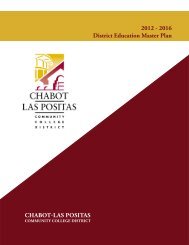City College of San Francisco - California Competes
City College of San Francisco - California Competes
City College of San Francisco - California Competes
Create successful ePaper yourself
Turn your PDF publications into a flip-book with our unique Google optimized e-Paper software.
THEME II<br />
outcomes assessment in the institutional culture is still evolving, the value the <strong>College</strong> places on student<br />
success will provide the context for future work on SLOs. This discussion <strong>of</strong> the institutional context is<br />
followed by two case studies. The first describes the efforts <strong>of</strong> CCSF’s English Department to use common<br />
assessment instruments to restructure its reading and composition course sequence. This case study reveals<br />
that the assessment <strong>of</strong> student learning outcomes can influence specific objectives and methodologies used<br />
by a very large cohort <strong>of</strong> instructors across a sequence <strong>of</strong> courses. The second case study describes the work<br />
<strong>of</strong> the leadership from all <strong>of</strong> the units in the Student Development Division to create a comprehensive,<br />
division-wide SLO initiative. While this endeavor is still in the formative stages, it demonstrates the commitment<br />
<strong>of</strong> the leadership to the process. More importantly, the case study reveals a clear understanding<br />
<strong>of</strong> the benefits and challenges this type <strong>of</strong> assessment poses for the various student development units<br />
and a commitment to meet those challenges to improve student outcomes.<br />
II. Institutional Context<br />
The Information the <strong>College</strong> Gathers and Pays Attention to. The Standard I Report on the Mission<br />
Statement and Institutional Effectiveness clearly delineates how the goals <strong>of</strong> the Mission Statement are<br />
translated into a comprehensive Strategic Plan and how that plan is connected to the annual planning<br />
and budget cycle as well as semi-annual assessments <strong>of</strong> progress. The Mission Statement establishes that<br />
“the quality <strong>of</strong> success in learning will permeate all levels <strong>of</strong> the educational experience.” While all <strong>of</strong> the<br />
major priorities in the Strategic Plan are designed to support “success in learning,” four <strong>of</strong> those strategic<br />
priorities directly address student learning outcomes (see Strategic Priorities 1, 2, 3, and 5).<br />
As Astin suggests, the value the <strong>College</strong> places on these broadly stated institutional priorities is reflected<br />
in the information it gathers about our effectiveness in achieving those goals. Therefore, in 2003, at the<br />
request <strong>of</strong> the Board <strong>of</strong> Trustees and the Chancellor, the Office <strong>of</strong> Research, Planning and Grants developed<br />
a set <strong>of</strong> 29 <strong>College</strong> Performance Indicators (CPIs) that “measure <strong>College</strong> performance within the<br />
eight priorities delineated by the CCSF Strategic Plan.” 2 Each year, a report on these 29 measures is<br />
provided to the <strong>College</strong> community. By definition, these performance indicators give us only the broadest<br />
information about institutional effectiveness, particularly as they relate to student learning. For example,<br />
Priority 1 indicators for basic skills show “overall student success rates in pre-collegiate courses” and<br />
“completion rates for students in pre-collegiate programs.” However, these indicators do just that—indicate<br />
areas for further assessment, analysis, and program development in the <strong>College</strong>’s efforts to improve<br />
student outcomes.<br />
The CPI reports suggested that the <strong>College</strong>’s efforts to develop students’ basic skills deserved a much more<br />
focused and comprehensive analysis. With over 75 percent <strong>of</strong> our first-time students placing into one or<br />
more pre-collegiate courses, 3 and with a broad range <strong>of</strong> programs and services designed to promote student<br />
learning within these basic skills courses, the <strong>College</strong> needed better information on what works, what<br />
does not add value, and, eventually, how the <strong>College</strong> can best use its resources to assure the highest level<br />
<strong>of</strong> student learning outcomes. Therefore, in Spring 2003, the Office <strong>of</strong> Research, Planning and Grants<br />
embarked on the development <strong>of</strong> the “Pre-Collegiate Basic Skills Accountability Report” in collaboration<br />
with faculty and administrative leadership involved in the basic skills programs and services. The two-part<br />
report published the next spring provided a comprehensive assessment <strong>of</strong> the demand, supply (i.e., access),<br />
2 <strong>College</strong> Performance Indicators: Academic Year 2003-2004, CCSF Office <strong>of</strong> Research, Planning, and Grants, January 2005, p.3.<br />
3 Only 2.2 percent <strong>of</strong> entering students place into college-level English and Math. Twenty-two (22) percent <strong>of</strong> the first-time<br />
students were not assessed.<br />
262 CITY COLLEGE OF SAN FRANCISCO







